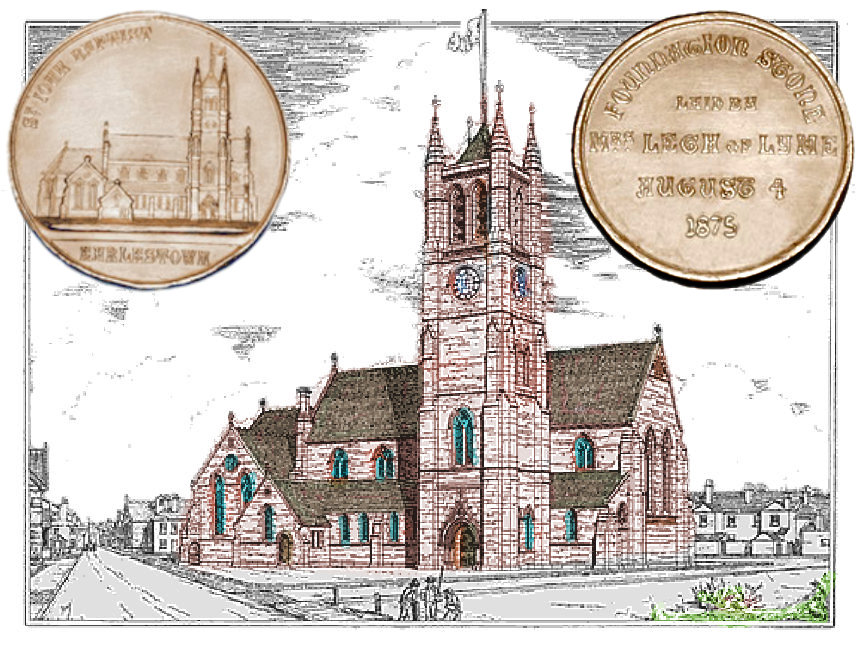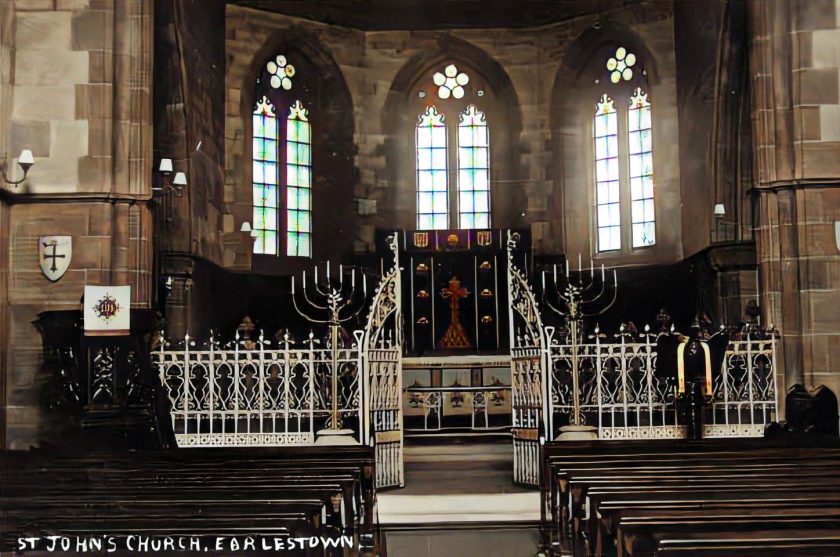With the church approaching it’s 150th year, I thought this newspaper account from its foundation stone ceremony would be of interest
Liverpool Weekly Mercury – Saturday 07 August 1875
LAYING OF THE FOUNDATION STONE.
On Wednesday, the little town of Earlestown, in the parish of Newton-in-Makerfield, was the scene of no little excitement, being the occasion of the laying of the foundation stone of a new church, to be called St. John the Baptist’s, which is about to be erected in the locality. The day was observed as a general holiday by the in- habitants of the town, which presented a very lively appearance, being profusely decorated with flags, upon some of which were printed the words “Success to the new church,” and “Success to the house of Lyme.” The flags were lent for the occasion by the Pacific Steam Navigation Company. For some time past, the necessity of having in this district further accommodation for the Church of England portion of the community has been felt. The only church in the parish is that of Emmanuel, situated at Wargrave, a distance of a mile and a half from Earlestown; and this church is by no means large enough for the requirements of its worshippers, being only capable of accommodating 300 persons.
Consequently a movement was started about twelve months ago for the purpose of providing funds for the erection of a church in Earlestown, which has a population of about 5000 inhabitants. A committee was appointed, and the appeal which was then made was liberally responded to. The subscription list was headed by Mr. W.J. Legh, of Lyme, M.P. for East Lancashire, who generously gave about half an acre of ground in Market-street, valued at £1000, as a site for the church and vicarage. Mr. Legh also con- tributed £1500 towards the building of the fabric, and
£50 towards the endowment, making the amount of his subscription altogether about £3000. The Sankey Sugar Company, collectively and individually, very largely assisted by their subscriptions, and the wardens of the parish and inhabitants of the district also contributed freely to the undertaking. The total amount of the subscriptions already received amounts to about £5200, and it is intended with this sum to erect a building that will accommodate 500 persons; but with an additional outlay of about £4000, which will afterwards be expended, the church will ultimately accommodate 1000.
The situation of the church is in Market-street North, opposite the police station, and it will be built so as to be convenient for the scholars attending the infant school, for whom a separate entrance into the church will be provided.
The dimensions of the nave, when completed, will be 95 feet long, by 29 feet wide; and the aisles will be about the same length, and 12 feet wide.
The chancel will be 40 feet in length, and 25 feet wide, with an octagonal apsidal end, having three windows placed on sides of the octagon, the centre one of which will be prominent to Market street.
There will be north and south transepts, leading from the chancel by a side arch, the one on the south side being intended for children, and that on the north will be eventually occupied by the organ, but until the whole church is completed it will contain seats.
The vestry and the heating chamber will be placed on the north side of the church; and the door will be placed towards the west end and north side.
The portion of the church which will be first built consists of the eastern end, the transepts, the vestry, and about one-half of the nave and aisles. In the nave there will be a clere story of good height, which will be lighted by six windows on each side.
The transepts will be lighted by long windows, the lancet heads of which will be filled with tracery.
In the chancel will be two light windows, with tracery heads and deep mouldings round them.
The portion of the church to be built now will be walled in temporarily by a brick wall, which will be pulled down when the church is extended.
The future west end will contain two large windows with tracery on the heads, of the same character as the rest of the building. In the inside of the church the nave will be separated from the aisles by an arcade of six arches.
The elevations will be-from the nave floor to the wall plate, 33 feet 9 inches; from the floor to the ridge in the nave, 56 feet; from the aisles to the wall plate, 14 feet; and the chancel will be 26 feet 9 inches to the wall plate, with a dome ceiling lined with boarding. The outside of the church will consist of Yorkshire shoddies, and the whole of the external tracings will be of wrought stonework, from the Runcorn red sandstone quarries, as also will be the interior masonry, with the exception of the chancel, which wil be lined with white sandstone from the Stourton quarries.
The timber of the roof inside will be of pitch pine; the ceiling of the chancel will be boarded; and that of the Lave and aisles will be plastered between rafters.
The doorway underneath the tower on the north side will be executed with clustered columns, surmounted by moulded caps, the whole enclosed by deeply-moulded arch; and the roof will be covered with Welsh slates.
The demonstrations on Wednesday commenced by the scholars attending the Sunday and national schools of Wargrave and Earlestown, and also those of the Vitriol square school, walking in procession through the principal streets of the town to the site of the new church. The children, who numbered about 1000, carried flags and banners, and were headed by the building committee and the band of the Bluecoat School of Warrington, who voluntarily attended, under the superintendence of Mr. Bowess.
The ceremony of laying the foundation stone was very gracefully performed by Mrs. Legh, to whom a handsome silver trowel, was presented by the Rev. J. Whitley, rector of Wargrave. In laying the stone, Mrs. Legh said “In the faith of our Lord Jesus Christ, we lay this foundation stone to the glory of God the Father, God the Son, and God the Holy Ghost.”
The Reve. J. Whitley and J. Standish took part in the service, and several hymns were sung by an efficient choir and the school children. The announcement by Mrs. Legh that the stone was well and truly laid was the signal for prolonged cheers, and at the conclusion of the service the spectators, who numbered between 3000 and 4000, warmly cheered Mr. and Mrs. Legh, and others who had taken a prominent part in the ceremony.
A banquet in the infant schoolroom, was then partaken of by about 100 persons.
A pleasant termination was given to the day’s rejoicings by supplying the school children with a substantial tea, and also giving a tea party to the inhabitants of the neighbourhood generally.



